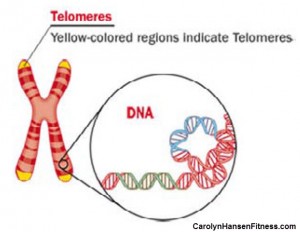 Science knows that the key to living a long healthy life in a young body requires that we protect our cell’s DNA. If you are not familiar with the word telomeres it won’t be long before you are. This is where your telomeres are located.
Science knows that the key to living a long healthy life in a young body requires that we protect our cell’s DNA. If you are not familiar with the word telomeres it won’t be long before you are. This is where your telomeres are located.
A telomere is an area of repetitive DNA at the end of chromosomes. They protect them from fusing with each other or rearranging. You could sort of think of them as “caps”…caps that protect the chromosome from destruction.
They are a disposable “buffer” consumed during cell division but replenished by an enzyme and normally limited to a fixed number of divisions.
Research and recent studies prove that physically active people have cells that appear younger at the molecular level than those that are sedentary…a direct link showing a distinct difference in telomeres for those that are active and people that are not.
In an important study published by the Archives of Internal Medicine and conducted by Professor Tim D. Spector (genetics and epidemiology at King’s College London) and his colleagues participants were questioned on:
Physical activity level
Smoking habits
Social and economic factors.
Their DNA was extracted from white blood cells (leukocytes) and each participant was required to submit a blood sample as well.
These DNA samples were analyzed and studied for the length of their telomeres located at the end of the chromosomes.
The goal was to examine and discover if there was a relationship between the participant’s telomere length and how much exercise they got in their spare time over a 10 year period.
After making adjustments for age, sex, body mass index, socioeconomic status, smoking habits and physical activity at work the results proved that Leukocyte telomere length was a direct result of increasing physical activity levels in their spare time.
The results are very telling. The most active subjects exhibited Leukocyte telomere length 200 nucleotides longer than the least active participants.
These studies reveal that those with even moderate amounts of exercise…approximately 100 minutes of weekly activity such as swimming, running, or tennis had telomeres similar to those of someone about five or six years younger than those that performed the least amount of activity…about 16 minutes weekly.
And the results get even better. Participants that exercised the most…approximately 3 hours weekly of moderate to intense vigorous activity sported telomere consistent with someone about nine years younger than those who exercised the least.
What is this revealing? As the amount of exercise is increase so too is telomere length increased.
It’s not hard to notice that those that tend to their bodies…those that are strong and fit most times appear much younger than those that have just “let go.”
Bottom line is this: studies prove that lifestyles dictate our telomere length. A sedentary lifestyle (especially one that includes smoking) has a definite negative effect on telomere length and is likely accelerating the aging process.
And, it’s not hard to figure out that is we want to have long healthy lives and a youthful appearance then we must pay attention to our level of activity. Doing the correct type of exercise on a regular basis can make us young in so many ways because it effects our DNA…the telomeres…those tiny but empowered genetic clocks that tell our cells how old they are.
It’s never too late to change when it comes to your health.
If you are serious about achieving a truly healthy lifestyle that will take care of you long into your senior years visit “Reclaim Your Longevity” . Everything you need to live a long healthy life…dancing well into your senior years is included in my new program that is geared towards helping you to find the “fountain of youth.”
Speak Your Mind